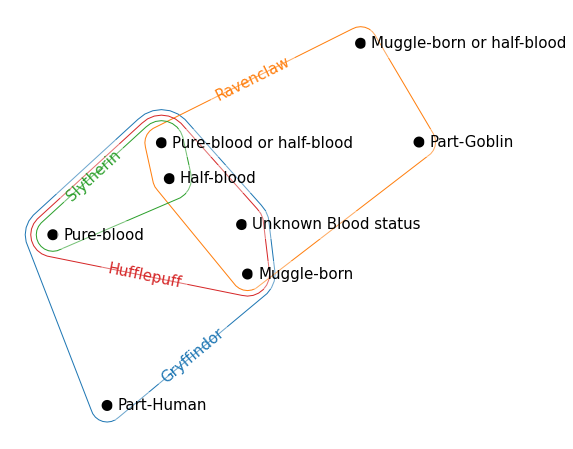Overview

HyperNetX
The HyperNetX library provides classes and methods for the analysis and visualization of complex network data modeled as hypergraphs. The library generalizes traditional graph metrics.
HypernetX was developed by the Pacific Northwest National Laboratory for the Hypernets project as part of its High Performance Data Analytics (HPDA) program. PNNL is operated by Battelle Memorial Institute under Contract DE-ACO5-76RL01830.
Principal Developer and Designer: Brenda Praggastis
Development Team: Audun Myers, Mark Bonicillo
Visualization: Dustin Arendt, Ji Young Yun
Principal Investigator: Cliff Joslyn
Program Manager: Brian Kritzstein
Principal Contributors (Design, Theory, Code): Sinan Aksoy, Dustin Arendt, Mark Bonicillo, Helen Jenne, Cliff Joslyn, Nicholas Landry, Audun Myers, Christopher Potvin, Brenda Praggastis, Emilie Purvine, Greg Roek, Mirah Shi, Francois Theberge, Ji Young Yun
The code in this repository is intended to support researchers modeling data as hypergraphs. We have a growing community of users and contributors. Documentation is available at: https://pnnl.github.io/HyperNetX
For questions and comments contact the developers directly at: hypernetx@pnnl.gov
New Features in Version 2.0
HNX 2.0 now accepts metadata as core attributes of the edges and nodes of a hypergraph. While the library continues to accept lists, dictionaries and dataframes as basic inputs for hypergraph constructions, both cell properties and edge and node properties can now be easily added for retrieval as object attributes.
The core library has been rebuilt to take advantage of the flexibility and speed of Pandas Dataframes. Dataframes offer the ability to store and easily access hypergraph metadata. Metadata can be used for filtering objects, and characterize their distributions by their attributes.
Version 2.0 is not backwards compatible. Objects constructed using version 1.x can be imported from their incidence dictionaries.
What’s New
The Hypergraph constructor now accepts nested dictionaries with incidence cell properties, pandas.DataFrames, and 2-column Numpy arrays.
Additional constructors accept incidence matrices and incidence dataframes.
Hypergraph constructors accept cell, edge, and node metadata.
Metadata available as attributes on the cells, edges, and nodes.
User-defined cell weights and default weights available to incidence matrix.
Meta data persists with restrictions and removals.
Meta data persists onto s-linegraphs as node attributes of Networkx graphs.
New hnxwidget available using pip install hnxwidget.
What’s Changed
The static and dynamic distinctions no longer exist. All hypergraphs use the same underlying data structure, supported by Pandas dataFrames. All hypergraphs maintain a state_dict to avoid repeating computations.
Methods for adding nodes and hyperedges are currently not supported.
The nwhy optimizations are no longer supported.
Entity and EntitySet classes are being moved to the background. The Hypergraph constructor does not accept either.
COLAB Tutorials
The following tutorials may be run in your browser using Google Colab. Additional tutorials are available on GitHub.
Notice
This material was prepared as an account of work sponsored by an agency of the United States Government. Neither the United States Government nor the United States Department of Energy, nor Battelle, nor any of their employees, nor any jurisdiction or organization that has cooperated in the development of these materials, makes any warranty, express or implied, or assumes any legal liability or responsibility for the accuracy, completeness, or usefulness or any information, apparatus, product, software, or process disclosed, or represents that its use would not infringe privately owned rights. Reference herein to any specific commercial product, process, or service by trade name, trademark, manufacturer, or otherwise does not necessarily constitute or imply its endorsement, recommendation, or favoring by the United States Government or any agency thereof, or Battelle Memorial Institute. The views and opinions of authors expressed herein do not necessarily state or reflect those of the United States Government or any agency thereof.
PACIFIC NORTHWEST NATIONAL LABORATORY
operated by
BATTELLE
for the
UNITED STATES DEPARTMENT OF ENERGY
under Contract DE-AC05-76RL01830
License
HyperNetX is released under the 3-Clause BSD license (see License)